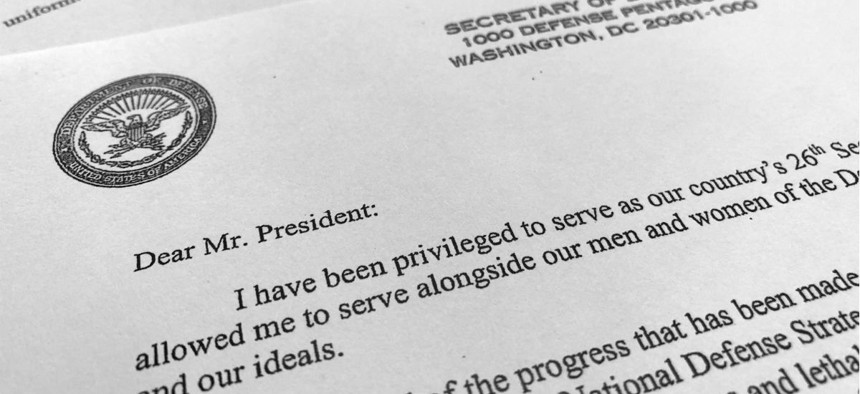Trump Kicks Mattis Out Early, Names Shanahan Acting Defense Secretary
The abrupt decision comes amid a growing crescendo of criticism of the president’s snap decision to withdraw U.S. troops from Syria.
Deputy Secretary of Defense Patrick Shanahan will replace outgoing Defense Secretary Jim Mattis on Jan. 1, President Trump tweeted on Sunday, ending Mattis’s tenure two months prior to his planned resignation date.
“I am pleased to announce that our very talented Deputy Secretary of Defense, Patrick Shanahan, will assume the title of Acting Secretary of Defense starting January 1, 2019. Patrick has a long list of accomplishments while serving as Deputy, & previously Boeing. He will be great!” Trump wrote.
The abrupt decision to push Mattis out sooner comes amid a growing crescendo of criticism of the president’s snap decision to withdraw U.S. troops from Syria, which prompted Mattis’ resignation on Friday, as well as the resignation of the top U.S. diplomat in charge of defeating ISIS, Brett McGurk. It follows two days of wall-to-wall coverage of Mattis’s resignation letter, which was a stinging rebuke of the president’s foreign policy and his rejection of international alliances like NATO.
Trump had initially praised Mattis in a tweet announcing that he had accepted his resignation, saying that he would retire “with distinction.” But he jabbed at Mattis over Twitter on Saturday, writing that he gave the decorated Marine general a “second chance” after he was “ingloriously fired” by President Obama. (Obama removed Mattis as head of Central Command in 2013 in part because of his hawkish views on Iran.)
Mattis had intended to stay through the end of February, both to ensure a smooth transition to a successor and “to make sure the Department’s interests are properly articulated and protected at upcoming events to include congressional posture hearings and the NATO Defense Ministerial meeting in February.” Mattis was due to testify before both House and Senate Armed Services Committees in January.
Shanahan enters the Pentagon at an important time, as the Pentagon finalizes its fiscal 2020 budget proposal, a time of intense deliberation and infighting among military leaders competing for dollars for troops and weapon programs.
A former Boeing executive, Shanahan is credited with saving the 787 Dreamliner, a the company’s revolutionary passenger jet built largely with composite materials, making it lighter and thus cheaper to fly. He was considered a frontrunner to run Boeing’s prestigious commercial airplanes division, but was instead assigned to a newly created role senior vice president of supply chain & operations, a high-level corporate position, that industry sources say, had little chance of promotion.
During his 17 months as deputy secretary, Shanahan has viewed himself as the Pentagon’s chief operating officer, working behind the scenes, aside from a few high-profile issues. He was also responsible with making sure the military was executing the National Defense Strategy.
“I like solving problems,” Shanahan said in September during a speech at an Air Force Association conference. “I like making things work, and work well. I'm an industrialist. I've spent my life building large, complex machines with complicated supply chains at scale. … I'm product-driven. I'm focused on performance, and I'm focused on making change at scale.”
Shanahan, who spent more than 30 years at Boeing, said: “My skills and experience are a strong complement to those of Secretary Mattis.”
As deputy secretary, Shanahan has been leading the Pentagon’s proposal for a Space Force, a sixth-branch desired by President Trump. It’s lead to clashes with Air Force Secretary Heather Wilson over the estimated cost of the new service.
Mattis and McGurk’s resignations — perhaps the most high profile protest resignations from the Trump administration yet — have fueled the image of a White House is crisis. Trump’s sudden decision to withdraw from Syria over the heads of most, if not all, of his senior national security advisors sparked a frenzy of bipartisan criticism on Capitol Hill. Lawmakers have expressed deep concerns about the lack of interagency process behind the decision and fears that the U.S. is abandoning its erstwhile partners in the fight against ISIS, the Syrian Kurds, under threat of attack from Turkey. The president reportedly made his decision during a phone call with Turkish President Recep Tayyip Erdogan.
Trump has since insisted over Twitter that the withdrawal from Syria will be “slow and highly coordinated,” calling it “crazy” that he has not been treated as “the most popular hero in America” because of the drawdown. He has also sought to downplay McGurk’s departure.
“Brett McGurk, who I do not know, was appointed by President Obama in 2015. Was supposed to leave in February but he just resigned prior to leaving. Grandstander? The Fake News is making such a big deal about this nothing event!” he tweeted Saturday.



